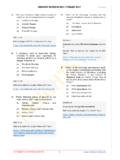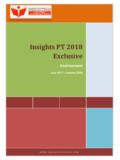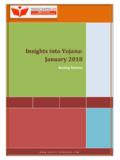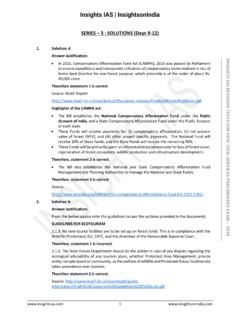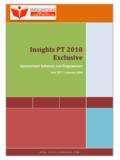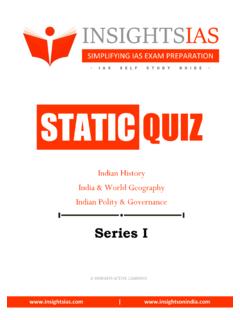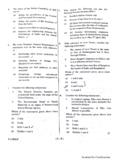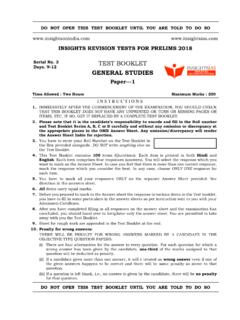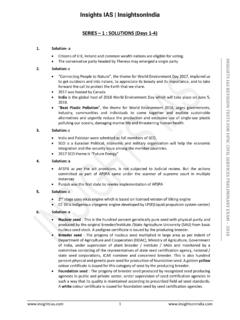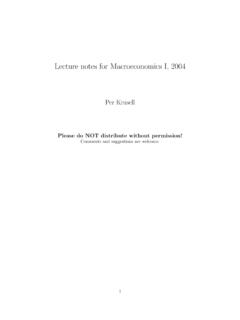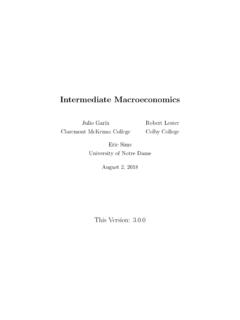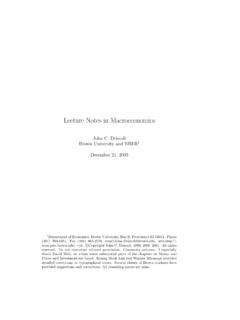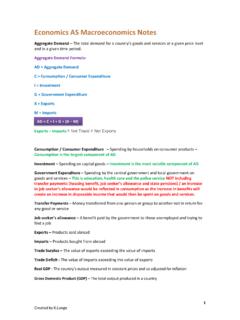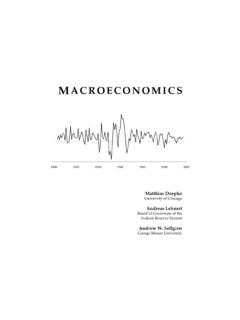Transcription of Contents
1 Contents ?FOREWORDiii1. Emergence of Context of the Present Book of Macroeconomics52. NATIONAL INCOME Some Basic Concepts of Circular Flow of Income and Methods ofCalculating National Product or Value Added Some Macroeconomic Goods and GDP and Welfare273. MONEY AND Functions of Demand for Transaction Speculative The Supply of Definitions: Narrow and Broad Creation by the Banking of Monetary Policy and theReserve Bank of India434. INCOME Ex Ante and Ex Movement Along a Curve Versus Shift of a The Short Run Fixed Price Analysis of the Product A Point on the Aggregate Demand of an Autonomous Change on EquilibriumDemand in the Product Multiplier Mechanism565. THE GOVERNMENT: FUNCTIONS AND Components of the Government Revenue Capital of Government Fiscal in Government in Debt716. OPEN ECONOMY The Balance of Surplus and The Foreign Exchange of the Exchange Exchange Exchange Exchange Rate Management:The International The Determination of Income in an Open Income Identity for an Open Output and the Trade Trade Deficits, Savings and Investment93 GLOSSARY98 Chapter 1 IntroductionIntroductionIntroductionIntr oductionIntroductionYou must have already been introduced to a study of basicmicroeconomics.
2 This chapter begins by giving you a simplifiedaccount of how macroeconomics differs from the microeconomicsthat you have of you who will choose later to specialise in economics,for your higher studies, will know about the more complexanalyses that are used by economists to study macroeconomicstoday. But the basic questions of the study of macroeconomicswould remain the same and you will find that these are actuallythe broad economic questions that concern all citizens Will theprices as a whole rise or come down? Is the employment conditionof the country as a whole, or of some sectors of the economy,getting better or is it worsening? What would be reasonableindicators to show that the economy is better or worse? Whatsteps, if any, can the State take, or the people ask for, in order toimprove the state of the economy? These are the kind of questionsthat make us think about the health of the country s economyas a whole.
3 These questions are dealt with in macroeconomics atdifferent levels of this book you will be introduced to some of the basicprinciples of macroeconomic analysis. The principles will bestated, as far as possible, in simple language. Sometimeselementary algebra will be used in the treatment for introducingthe reader to some we observe the economy of a country as a whole it will appearthat the output levels of all the goods and services in the economyhave a tendency to move together. For example, if output of foodgrain is experiencing a growth, it is generally accompanied by arise in the output level of industrial goods. Within the category ofindustrial goods also output of different kinds of goods tend torise or fall simultaneously. Similarly, prices of different goods andservices generally have a tendency to rise or fall can also observe that the employment level in differentproduction units also goes up or down aggregate output level, price level, or employment level, inthe different production units of an economy, bear closerelationship to each other then the task of analysing the entireeconomy becomes relatively easy.
4 Instead of dealing with theabove mentioned variables at individual (disaggregated) levels,we can think of a single good as the representative of all the22222 Introductory Macroeconomicsgoods and services produced within the economy. This representative goodwill have a level of production which will correspond to the average productionlevel of all the goods and services. Similarly, the price or employment level ofthis representative good will reflect the general price and employment level ofthe macroeconomics we usually simplify the analysis of how the country stotal production and the level of employment are related to attributes (called variables ) like prices, rate of interest, wage rates, profits and so on, by focusingon a single imaginary commodity and what happens to it. We are able to affordthis simplification and thus usefully abstain from studying what happens tothe many real commodities that actually are bought and sold in the marketbecause we generally see that what happens to the prices, interests, wages andprofits etc.
5 For one commodity more or less also happens for the , when these attributes start changing fast, like when prices are goingup (in what is called an inflation), or employment and production levels aregoing down (heading for a depression), the general directions of the movementsof these variables for all the individual commodities are usually of the samekind as are seen for the aggregates for the economy as a will see below why, sometimes, we also depart from this usefulsimplification when we realise that the country s economy as a whole may bestbe seen as composed of distinct sectors. For certain purposes theinterdependence of (or even rivalry between) two sectors of the economy(agriculture and industry, for example) or the relationships between sectors (likethe household sector, the business sector and government in a democratic set-up) help us understand some things happening to the country s economy muchbetter, than by only looking at the economy as a moving away from different goods and focusing on a representativegood may be convenient, in the process, we may be overlooking some vitaldistinctive characteristics of individual goods.
6 For example, productionconditions of agricultural and industrial commodities are of a different , if we treat a single category of labour as a representative of all kinds of labours,we may be unable to distinguish the labour of the manager of a firm from thelabour of the accountant of the firm. So, in many cases, instead of a singlerepresentative category of good (or labour, or production technology), we maytake a handful of different kinds of goods. For example, three general kinds ofcommodities may be taken as a representative of all commodities being producedwithin the economy: agricultural goods, industrial goods and services. Thesegoods may have different production technology and different also tries to analyse how the individual output levels, prices,and employment levels of these different goods gets this discussion here, and your earlier reading of microeconomics, youmay have already begun to understand in what way macroeconomics differsfrom microeconomics.
7 To recapitulate briefly, in microeconomics, you came acrossindividual economic agents (see box) and the nature of the motivations thatdrive them. They were micro (meaning small ) agents consumers choosingtheir respective optimum combinations of goods to buy, given their tastes andincomes; and producers trying to make maximum profit out of producing theirgoods keeping their costs as low as possible and selling at a price as high asthey could get in the markets. In other words, microeconomics was a study ofindividual markets of demand and supply and the players , or the decision-makers, were also individuals (buyers or sellers, even companies) who were seen33333 Introductionas trying to maximise their profits (as producers or sellers) and their personalsatisfaction or welfare levels (as consumers). Even a large company was micro in the sense that it had to act in the interest of its own shareholders which wasnot necessarily the interest of the country as a whole.
8 For microeconomics the macro (meaning large ) phenomena affecting the economy as a whole, likeinflation or unemployment, were either not mentioned or were taken as were not variables that individual buyers or sellers could change. Thenearest that microeconomics got to macroeconomics was when it looked atGeneral Equilibrium, meaning the equilibrium of supply and demand in eachmarket in the AgentsBy economic units or economic agents, we mean those individuals orinstitutions which take economic decisions. They can be consumers whodecide what and how much to consume. They may be producers of goodsand services who decide what and how much to produce. They may beentities like the government, corporation, banks which also take differenteconomic decisions like how much to spend, what interest rate to charge onthe credits, how much to tax, tries to address situations facing the economy as a Smith, the founding father of modern economics, had suggested that ifthe buyers and sellers in each market take their decisions following only theirown self-interest, economists will not need to think of the wealth and welfare ofthe country as a whole separately.
9 But economists gradually discovered thatthey had to look found that first, in some cases, the markets did not or couldnot exist. Secondly, in some other cases, the markets existed but failed toproduce equilibrium of demand and supply. Thirdly, and most importantly,in a large number of situations society (or the State, or the people as a whole)had decided to pursue certain important social goals unselfishly (in areas likeemployment, administration, defence, education and health) for which someof the aggregate effects of the microeconomic decisions made by the individualeconomic agents needed to be modified. For these purposes macroeconomistshad to study the effects in the markets of taxation and other budgetary policies,and policies for bringing about changes in money supply, the rate of interest,wages, employment, and output. macroeconomics has, therefore, deep rootsin microeconomics because it has to study the aggregate effects of the forces ofdemand and supply in the markets.
10 However, in addition, it has to deal withpolicies aimed at also modifying these forces, if necessary, to follow choicesmade by society outside the markets. In a developing country like India suchchoices have to be made to remove or reduce unemployment, to improve accessto education and primary health care for all, to provide for good administration,to provide sufficiently for the defence of the country and so on. Macroeconomicsshows two simple characteristics that are evident in dealing with the situationswe have just listed. These are briefly mentioned , who are the macroeconomic decision makers (or players )?Macroeconomic policies are pursued by the State itself or statutory bodies likethe Reserve Bank of India (RBI), Securities and Exchange Board of India (SEBI)and similar institutions. Typically, each such body will have one or more publicgoals to pursue as defined by law or the Constitution of India itself. These goals44444 Introductory Macroeconomicsare not those of individual economic agents maximising their private profit orwelfare.

